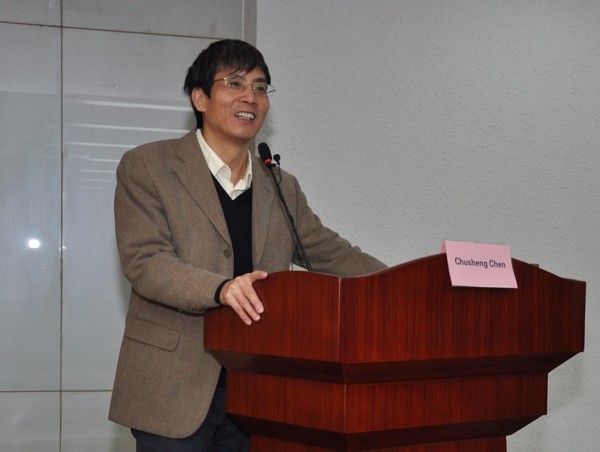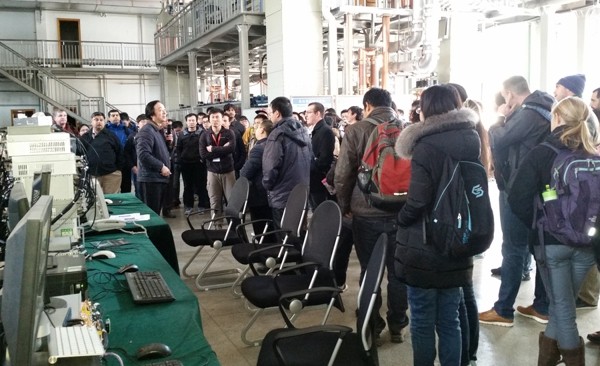On Dec 14th-18th, the five-day 2015 “ITER International School” (IIS2015) was held in the School of Nuclear Science and Technology (SNST) of USTC.More than 160 experts, scholars and students from the United States, South Korea, France, Japan and China, etc. attended the school. The subject of IIS2015 was "Transport and Pedestal Physics in Tokamaks". Seventeen well-known domestic and foreign experts in fusion filed were invited. QIN Hong, the chair of the IIS2015 Organization Committee and the Executive Dean of SNST, USTC, hosted the school.

At the opening ceremony in 14th morning, CHEN Chusheng,vice president of USTC, extended a sincere welcome to all the experts and students from various countries in the first place, and then he introduced the basic situation of USTC and wished the IIS2015 a success. Academician WAN Yuanxi, the Dean of SNST, briefly introduced the current status of International Corporation of SNST, he also expressed gratitude to the organizers of IIS2015 and a warm welcome to all the participants. Prof.Jean-Marc Layet, on behalf of the rotating presidency of IIS and President of Aix Marseille University Yvon Berland, and Dr.Alberto Loarte,the representative of IO, also delivered speeches, respectively. After that, Academician LI Jiangang, who was from the Institute of Plasma Physics Chinese Academy of Science (ASIPP), gave a report entitled “CFETR and Chinese magnetic fusion energy program”, introduced in detail the present state of Magnetic confinement fusion (MCF) in China, including the EAST progress, China’s activities in ITER, the overall status of CFETR and the problems we need to address in the future.

Around the subject of “Transport and Pedestal Physics in Tokamaks”, the IIS2015 included 17 lectures in total which focused on five subtopics.A. Loarte、V. Naulin、Phil Snyder and Rajesh Maingi gave specific reports to the SOL, pedestal physics and effect of low-Z impurities on H-mode pedestal; Prof.Y. Ueda introduced pulsed heat load effects on plasma facing materials; Gary Staebler、J. Cheng and K.Kamiya explored the LH-transition from the perspective of theoretical model and experimental study; J.Dong, Raffi Nazikian、R. Ganesh and Michele Romanelli discussed the plasma instabilities, turbulence and transport; WhileC.S. Chang、Bruce Scott、LI Jiquan、Joshua W. Burdy introduced the theory and simulations of Gyro kinetic and its applications in solving the Tokamak-related problems. During the reports students discussed in depth with the experts.

In 16th afternoon, all the students of IIS2015 paid a scene visit to the EAST facility in ASIPP, Academician LI Jiangang explained the facility at length for them. Afterwards, the students visited the KTX Lab in USTC.

Through the reports and site visit of the facility, the students have not only learned the cutting-edge of fusion, but also further strengthened their passion and faith for fusion, which will surely contribute to a more solid foundation for devoting to fusion career. At the end of the school, Chair Hong Qin shared his inspiring story to encourage the students, and then he listened to the advices of the participants. Meanwhile, he wished the IIS would become better and better and train more talents for the fusion career.

The International ITER School (IIS) is an annual international meeting organized alternatively by ITER’s partner countries which aims to provide a regular forum for conducting a post-graduate training school in the area of fusion science for young researchers with a view to attracting them to participate in the scientific exploitation of ITER. IIS2015 was jointly held by IO, Aix Marseille University, USTC, ASIPP and SWIP. The successfully held of IIS will encourage more and more researchers to enter fusion filed and thus make greater contribution to solving the problem of energy shortage and environmental degradation.
(The School of Nuclear Science and Technology)